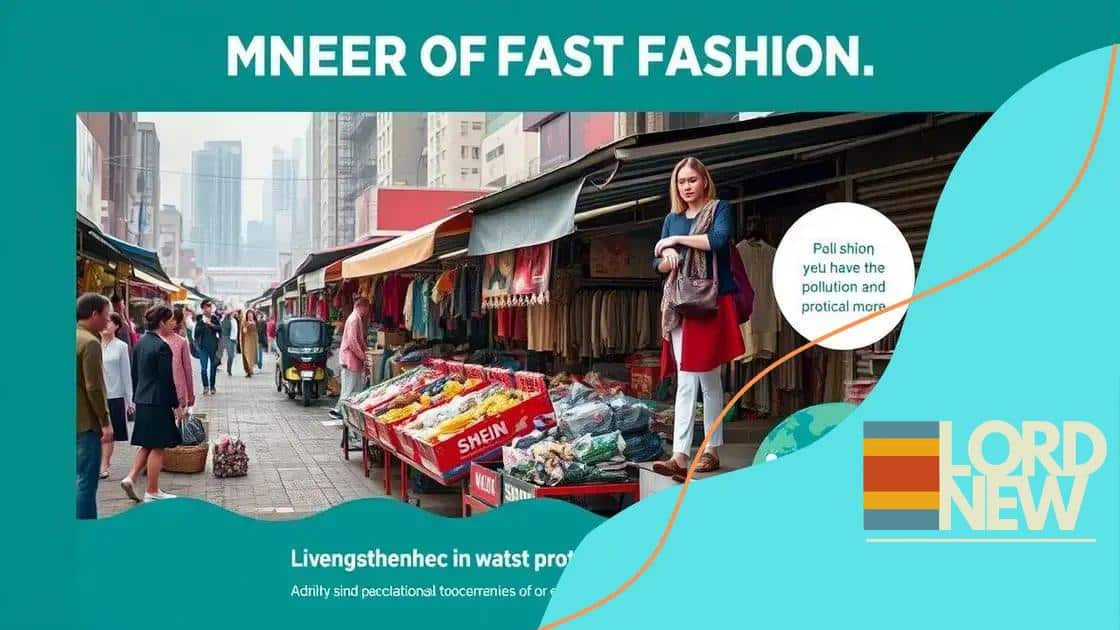Shein’s participation in global fashion sustainability forums

Shein’s participation in global fashion sustainability forums highlights its commitment to evolving sustainable practices and addressing environmental challenges within the fast fashion industry.
Shein’s participation in global fashion sustainability forums raises questions about the fast fashion industry. Have you ever wondered how a major player like Shein navigates complex eco-friendly practices? In this article, we delve into their strategies and implications for the future.
Understanding Shein’s sustainability initiatives
Understanding Shein’s sustainability initiatives is essential to comprehend how this fast fashion giant is attempting to evolve within the context of eco-friendliness. As consumer demand for sustainable practices grows, Shein has started to take steps to adapt its business model.
One major initiative is the launch of the “Shein Cares” program, which focuses on transparency and sustainable sourcing. This program sets clear goals aimed at reducing waste and promoting better working conditions. Such efforts show a commitment to change, though challenges remain.
Key Aspects of Shein’s Sustainability Efforts
Shein’s initiatives include several key components:
- Use of eco-friendly materials: The brand is exploring fabrics made from recycled materials, which reduces its ecological footprint.
- Water conservation: Implementing techniques to minimize water usage during production is a priority for the company.
- Awareness campaigns: Shein promotes its initiatives through campaigns that educate consumers on sustainability and responsible fashion.
In addition to these measures, Shein is engaging in partnerships with organizations focused on environmental protection. Recognizing the impact of the fashion industry on the planet, these partnerships aim to create a positive change in the industry.
Another noteworthy effort is the introduction of a recycling program, encouraging customers to send back their old clothes for reuse. This encourages a circular economy, which is vital for sustainability in fashion.
As we delve deeper into Shein’s sustainability initiatives, it’s clear that the road to genuine sustainability is complex. While the company is making strides, it still faces scrutiny over its fast fashion model and its implications for the environment. Continuous improvement and transparency remain crucial for Shein as it navigates its sustainability journey.
Key global fashion forums Shein participates in
One of the key aspects of understanding Shein’s position in the fashion industry is its active involvement in global fashion forums. These forums are crucial as they provide a platform for discussing sustainability, innovation, and the future of fashion. By participating in these events, Shein aims to highlight its commitment to sustainable practices while also learning from other industry leaders.
Shein has been making waves at several influential events around the world. Such participation enables the brand to engage with a diverse audience, including consumers, policymakers, and industry experts. Through these interactions, Shein can showcase its initiatives and gather valuable insights to refine its strategies.
Important Fashion Forums Shein Engages With
Here are some prominent forums where Shein has a notable presence:
- Fashion for Good: This initiative fosters collaboration between fashion brands to create positive change.
- Global Fashion Summit: An annual event that discusses sustainability and responsible practices in the fashion industry.
- The Copenhagen Fashion Summit: A crucial gathering for industry leaders focusing on creating a more sustainable future.
These forums allow Shein to not only contribute ideas but also to understand the latest trends and challenges in sustainable fashion. Engaging with diverse stakeholders helps Shein navigate the complexities of the fashion ecosystem and adapt its approach accordingly.
As the conversation around sustainability intensifies, Shein’s participation in these global platforms reflects its intention to shift towards more responsible practices. This includes collaborating on sustainability projects and aligning its business model with the values of an evolving market.
Overall, Shein’s presence in these key global fashion forums is a vital step towards redefining its image and taking responsibility within the industry. By continuously engaging with thought leaders and stakeholders, Shein aims to position itself as a proactive player in the pursuit of sustainability.
Impact of Shein’s practices on the fashion industry

The impact of Shein’s practices on the fashion industry is a topic of significant discussion among consumers, environmentalists, and industry experts. As a leader in fast fashion, Shein’s approach has both positive and negative effects on the market.
One noticeable impact is the rapid turnover of fashion trends. Shein’s ability to produce trendy clothes quickly keeps consumers engaged and satisfies their desire for new styles. This fast-paced model can encourage people to shop more frequently, which might lead to a throwaway culture.
Positive Contributions of Shein
Despite the criticisms, Shein has made some positive contributions:
- Affordability: Offering trendy clothing at low prices allows more consumers to access fashion.
- Diversity: Shein provides a wide range of styles, catering to various body types and fashion preferences.
- Innovation: The brand uses data analytics to predict consumer preferences, which streamlines the design process.
On the other hand, there are serious concerns surrounding the sustainability of Shein’s model. The environmental impact of producing clothes at such a fast pace is substantial. The production processes often involve harmful chemicals and contribute to pollution. Moreover, the shipping methods used can lead to a higher carbon footprint.
Additionally, labor practices within the company have come under scrutiny. Reports indicate that workers in some production facilities face poor working conditions and low wages. This shining light on the labor practices raises questions about the ethics behind affordable fashion.
As Shein continues to grow, it faces pressure from the public to adapt to more sustainable and ethical practices. This includes improving labor conditions, minimizing environmental impact, and potentially altering its business model to promote responsible consumption.
Challenges in achieving true sustainability
Achieving true sustainability in the fashion industry presents many challenges, especially for a fast fashion brand like Shein. While the company makes strides towards eco-friendly practices, underlying issues make real progress complex.
One major challenge is the fast-paced nature of fashion. The demand for quick trends leads to overproduction. This means more waste is generated, often resulting in clothes ending up in landfills. Many brands, including Shein, struggle to balance consumer expectations with sustainability goals.
Key Challenges Faced by Shein
Several factors hinder Shein’s journey towards sustainability:
- Resource-intensive production: Creating large quantities of clothing requires significant resources, such as water and energy, leading to strain on the environment.
- Supply chain opacity: Shein’s supply chain can be complex and difficult to track, making it hard to ensure sustainable practices are followed at every level.
- Consumer mindset: Many consumers favor low price points over sustainability, which drives fast fashion sales and perpetuates the cycle of consumption.
Additionally, there are pressures from regulators and environmental advocates demanding greater accountability from companies. Shein must navigate these expectations while trying to adapt its business model. The scrutiny from media and consumers adds another layer of difficulty.
Another challenge is the need for innovation. Developing sustainable materials and production methods requires investment and time. For Shein, finding that balance between rapid production and innovation is crucial yet hard to achieve. Fast fashion’s model often conflicts with the slower pace of sustainable development.
As Shein aims to address these challenges, it is essential for the brand to seek collaboration with others in the fashion industry. By working together, brands can share insights and strategies to overcome obstacles. This collaboration can lead to more significant advancements in sustainability practices across the sector.
Future prospects for Shein and sustainable fashion
The future prospects for Shein in the realm of sustainable fashion are both challenging and promising. As demand for eco-friendly practices rises, Shein must adapt to meet these expectations while still maintaining its business model as a fast fashion leader.
One significant opportunity lies in the innovation of sustainable materials. Shein can invest in research and development to create fabrics that are biodegradable or made from recycled resources. By embracing such materials, Shein not only improves its environmental impact but also appeals to the growing segment of consumers who prioritize sustainability.
Shifts in Consumer Behavior
Another important factor is the shift in consumer behavior. More shoppers are becoming aware of the environmental consequences of fast fashion. This awareness can lead to increased demand for brands that prioritize sustainable practices. Companies that adapt to these changes may find themselves in a better position.
- Transparency: Consumers are increasingly interested in knowing where their clothes come from and how they are made. Companies providing clear information about their supply chains could gain consumer trust.
- Community Engagement: Brands that actively engage in community-focused sustainability initiatives can build a loyal customer base that values social responsibility.
- Innovative Business Models: Adopting new models like rental services or recycling programs can lead to a reduction of waste and promote more sustainable consumption.
Additionally, regulatory pressures regarding environmental policies are on the rise. As governments enforce stricter regulations related to sustainability, Shein must stay ahead by proactively adopting sustainable practices. This includes not only compliance with regulations but also demonstrating leadership in the industry.
To remain relevant and profitable, Shein will need to balance the fast fashion model with sustainable practices. This could involve a gradual shift towards producing fewer items, focusing on quality over quantity. Implementing such changes may take time, but they are essential for long-term success.
As Shein faces the evolving landscape of fashion sustainability, the choices it makes today will influence its position in the market tomorrow. The challenge is formidable, but with innovative strategies and a commitment to sustainable practices, Shein has the potential to lead the industry into a more sustainable future.
FAQ – Frequently Asked Questions about Shein and Sustainable Fashion
What steps is Shein taking towards sustainability?
Shein is focusing on using sustainable materials, reducing waste, and improving transparency in its supply chain.
How does consumer behavior impact Shein’s sustainability efforts?
As consumers become more aware of environmental issues, their demand for sustainable practices influences Shein to adapt its business model.
What are the challenges Shein faces in achieving true sustainability?
Shein faces challenges such as overproduction, supply chain opacity, and the need to shift consumer mindsets towards sustainable fashion.
Can Shein become a leader in sustainable fashion?
Yes, with commitment to innovative practices and consumer engagement, Shein has the potential to lead in sustainable fashion initiatives.





